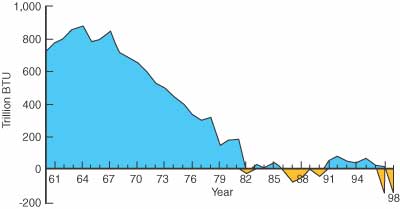| Kansas Geological Survey | Winter 2001 |
Vol. 7.1 |
|
Energy Production in Kansas
CONTENTS CO2 Data–page 1 |
Higher gasoline prices in the
summer and increasing natural gas bills in the winter have again reminded
Kansans of their reliance on energy and how quickly energy prices can
change. There’s no quick fix, but we can increase production and improve
efficiency, say energy researchers at the Kansas Geological Survey who
have studied the changing mix of energy production and use in the state. For decades, Kansas produced more energy than it consumed, mostly because
of its supply of oil and natural gas. But today, as production from the
state’s oil fields declines, Kansas is consuming roughly the same
amount of energy as it is producing. If demand exceeds supply, the state’s
economy could be affected, as businesses and individuals pay more for
energy from outside the state. The 2001 session of the Kansas Legislature
is considering a number of responses to the state’s energy situation,
including developing an energy plan for the state. In the year 2000, Kansas produced about 34 million barrels of oil. That’s
up slightly from 1999, but down substantially from the 1950’s and
1960’s, when the state’s wells produced more than 100 million
barrels of oil per year. Natural gas production was 560 billion cubic
feet in 2000, a slight increase from 1999, but half the annual production
in the peak years of the 1970’s. Oil and natural gas production has dropped over the decades because many
of the state’s fields are mature and are playing out. At the same
time, the country uses more natural gas. “Because of environmental
concerns about coal, nearly all of the new, large electrical plants in
this country are being powered by natural gas,” said Tim Carr, chief
of the Survey’s petroleum research section. “That, and a cold
winter, led to surging demand and higher prices for natural gas.” This higher demand means that natural gas in storage is at a record low.
The country could face spot shortages in the spring of 2001 and the following
winter, said Carr. Natural gas isn’t the only place where the Kansas energy scene
has changed. Kansans are increasingly reliant on electricity. About one-third
of the energy consumed in the state last year was in the form of electricity,
compared to 15 percent in 1960. Much of that electricity is generated
by coal hauled in from Wyoming. All of these energy issues are complex and interconnected. Tackling them won’t be simple or easy. “The energy issues that affect Kansas are now driven more by national and international forces than local ones,” said Scott White, an energy analyst at the Survey. “We can still respond locally, however. New techniques such as horizontal drilling, three-dimensional seismic reflection, and enhanced recovery can increase production from oil and gas fields. Developing new energy sources, such as wind and biomass, and improving
the efficiency with which we use energy, can also have a positive impact.
We need to do all of these things.” A summary of the Kansas energy report, by Survey researchers Tim Carr and Scott White, is available on the Survey’s web site at http://www.kgs.ku.edu/PRS/publication/2000/ofr69/index.html. |
|
Net energy production in Kansas has dropped dramatically
from 1960 to 1998. Currently, Kanas consumes about as much energy as it
produces. |
 |
| Online February 10, 2003 Comments to: lbrosius@kgs.ku.edu Kansas Geological Survey URL:http://www.kgs.ku.edu/Publications/GeoRecord/2001/vol7.1/Page1.html |